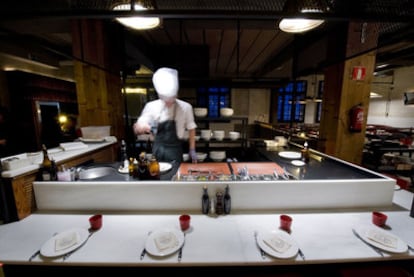10,000 ways to eat raw meat
A Barcelona restaurant is modernizing steak tartar
"It's very visual, very painterly." You might think Enrique Valentí was talking about Yves Klein's color fields or Akira Kurosawa's poetic journeys. But no, he is enthusing about something as simple as the world's most famous raw-meat dish. In Barcelona, this Madrileño cook has developed his plan to bring back the classic steak tartar, with a Japanese-style bar where diners gaze in fascination at the culinary process, while the chef dexterously blends the ingredients. Casa Paloma's menu is based on tartar dishes, with eight variations on offer. Here raw meat or fish is king - in tune with the protein-based obsessions of many of today's trendy diets.
The star is the classic formula of minced meat with eggs and seasoning, but there is also fish (salmon and tuna have long been classics on the menus of Japanese restaurants in Spain), and even tartar on a sea-and-mountain theme, such as that of beef and oysters. Sounds ground-breaking? Maybe not. After all, as Valentí argues, "in the 19th century the great master Escoffier produced recipes for woodcock and oysters."
In the year or so the restaurant has been open, more than 10,000 dishes have been served. Apart from the preparation, which you watch as it happens, other pluses include the precise cut and the ingredients. The filet mignon from cattle raised in León is one of the main attractions. As is the maturity period. "We have a drying chamber where the pieces are aged for 60 to 70 days, when the norm is 20. We see to it that the meat loses its water, while the flavor and the complexity of the texture is unrivaled," says the cook with an air of satisfaction.
Another attraction is that the seasoning is prepared in the restaurant: natural tomato, chilies, water, vinegar, sugar, salt, capers, shallots, spring onions, and so on. "We don't use Tabasco sauce from a bottle. We prepare our own, which is fermented for a month and left to rest," says Valentí, who emphasizes the care taken in the minutiae of the preparation.
"People love raw meat. The rebirth of tartar is a thing of the future," says Valentí, who studied at the Escuela de Hostelería in Madrid, honed his skills in the Cabo Mayor and the Hotel Palace, and took the leap to Barcelona "out of love."
In Barcelona he is spearheading a trend that reflects a passion for unadorned cuisine. His efforts were one of the sensations of the culinary festival San Sebastián Gastronomika, which saw its 2011 edition end last Wednesday.

Tu suscripción se está usando en otro dispositivo
¿Quieres añadir otro usuario a tu suscripción?
Si continúas leyendo en este dispositivo, no se podrá leer en el otro.
FlechaTu suscripción se está usando en otro dispositivo y solo puedes acceder a EL PAÍS desde un dispositivo a la vez.
Si quieres compartir tu cuenta, cambia tu suscripción a la modalidad Premium, así podrás añadir otro usuario. Cada uno accederá con su propia cuenta de email, lo que os permitirá personalizar vuestra experiencia en EL PAÍS.
¿Tienes una suscripción de empresa? Accede aquí para contratar más cuentas.
En el caso de no saber quién está usando tu cuenta, te recomendamos cambiar tu contraseña aquí.
Si decides continuar compartiendo tu cuenta, este mensaje se mostrará en tu dispositivo y en el de la otra persona que está usando tu cuenta de forma indefinida, afectando a tu experiencia de lectura. Puedes consultar aquí los términos y condiciones de la suscripción digital.
Últimas noticias
Maduro pleads not guilty before the federal court in New York: ‘I am still the president of Venezuela’
A new test can detect Alzheimer’s from a finger prick
UN team enters Sudanese city of El Fasher after paramilitary massacre: ‘It’s like a ghost town’
A recipe for resistance: Indigenous peoples politicize their struggles from the kitchen
Most viewed
- Gilles Lipovetsky: ‘If you want to live better and fall in love, take Prozac, don’t look to philosophy’
- Alain Aspect, Nobel laureate in physics: ‘Einstein was so smart that he would have had to recognize quantum entanglement’
- Maduro’s downfall puts China’s relationship with Venezuela to the test
- Why oil has been at the center of Venezuela-US conflicts for decades
- Alvin Hellerstein, a 92-year-old judge appointed by Bill Clinton, to preside over Maduro’s trial in New York








































